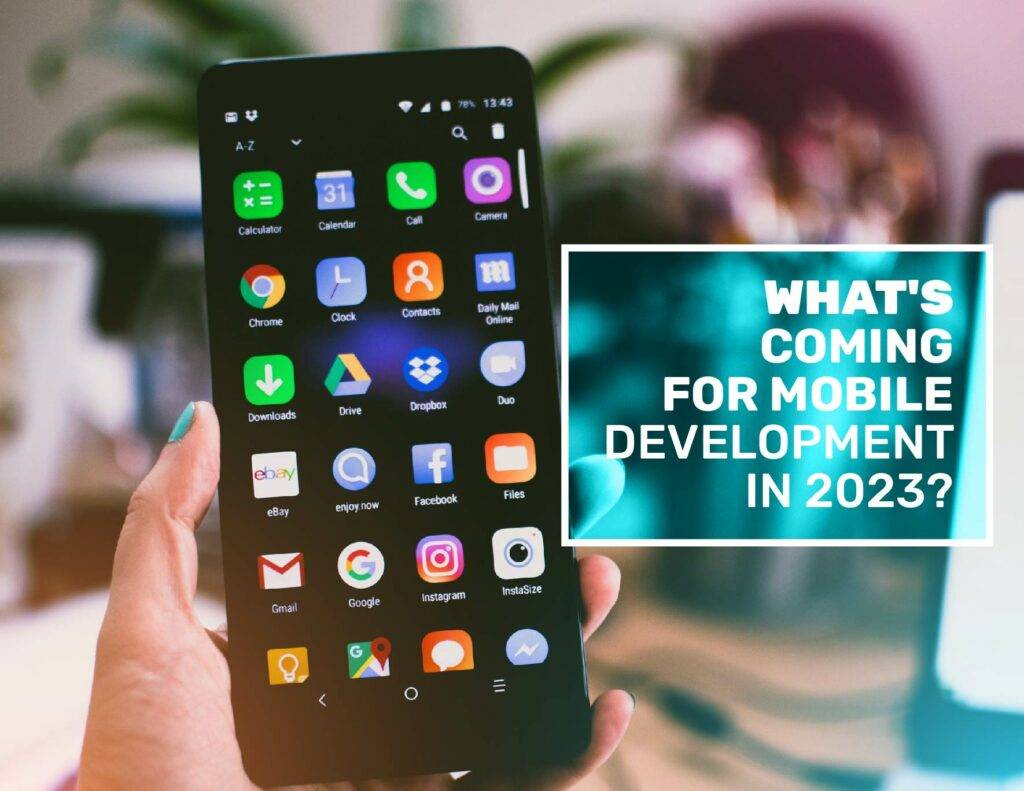Mobile developers continue to play an essential role in our everyday lives. With the mobile app market continuing to snowball in 2023, what does mobile app development look like this year? What trends and opportunities should mobile software developers and engineers know to remain competitive?
5G
5G networks will meet users’ demand for a powerful mobile network that delivers higher performance speed, fast data transfer, and lower latency. Mobile app developers can capitalize on 5G to enhance app functionality and include new features, such as immersive Augmented Reality (AR) and Virtual Reality (VR) experiences, improved live streaming, and better cloud capabilities.
AR/ VR
Advances in AR/VR technologies are driving the transformation of mobile gaming, entertainment, travel, and live-streaming applications. Customers want deep and immersive experiences, which allow utilities like trying on clothes, seeing what a new sofa would look like in your living room, or visualizing yourself on the beach vacation of your dreams. The challenge for mobile app developers is to create experiences that can be accessed and enjoyed on older mobile devices.
IoT (Internet of Things) and the cloud
The demand for mobile app development services is expanding in manufacturing, healthcare, and retail as companies strive to create seamless connections between smart devices and mobile apps.
The Internet of Things (IoT) and the cloud offer significant benefits, including reduced operating costs, improved efficiency, and increased connections to other platforms through APIs. For example, manufacturers use mobile IoT applications to monitor the performance of remote equipment or work sites.
AI and Machine Learning
Artificial Intelligence (AI) and Machine Learning (ML) will continue to be critical components of mobile application development as customer expectations for custom application experiences grow. Real-time data collection and user behavior analysis will drive how applications customize search, chatbot interactions, and application authentication for users to travel seamlessly. In addition, ML can use analytics to customize news sources, deliver AI-driven chatbots that know a customer’s communication history and preferences and detect fraud, suspicious activity, and potential information leaks.
Mobile commerce
Mobile commerce (m-commerce) proliferates as more customers spend time on apps. Mobile wallets and in-app payment features also make it easy for users to complete purchases without leaving the app. For this reason, more retailers are creating native or progressive web apps (PWAs) to provide a better shopping experience. Speaking of…
PWA and instant applications
Progressive web applications (PWA) are popular because they fill in the gaps left by most native applications and websites. Benefits such as reduced reliance on internet connections, faster loading times, automatic upgrades, and faster time-to-market make PWAs a popular choice for customers and businesses. Some well-known PWA sites are Pinterest, Forbes, and Trivago.
Likewise, instant apps are gaining popularity because they allow users to test the app before downloading and installing it. Businesses using PWA and instant applications benefit from improved performance, better customer experience, and reduced development costs.
Portable devices
Wearable technology continues to be widely adopted, particularly in the health and sports industries. Portable devices, such as fitness trackers, give users the convenience of receiving messages and notifications while on the go. With improvements in newer models and 5G connectivity, it’s not surprising that demand for mobile apps for wearable technology is increasing. Mobile app developers following this trend should focus on making apps easy to use, responsive and interactive.
Beacon technology
Beacons were introduced in 2013 but are becoming more popular in mobile app development, particularly for retail companies that saw their revenue share increase to more than 65% by 2021 due to beacon deployment. This technology innovates in business because it uses low-energy Bluetooth signals to transmit data based on a user’s location. For consumers, the benefits include real-time and location-specific offers and alerts. In addition, beacons allow businesses to understand customers’ buying preferences and patterns, turning this data into a more personalized shopping experience.
Multi-platform development
Cross-platform development means creating a mobile app using a unique code base that can run on any iOS or Android platform. Developing the app once and publishing it on multiple platforms saves you time and money while reaching more customers with an app that has a uniform look on all devices. Companies with cross-platform apps include Walmart, Instagram, and BMW.
Security in the development of mobile applications
Mobile devices are constantly attacked to find weaknesses or vulnerabilities and exploit them through targeted attacks. Mobile apps increase the mobile ecosystem attack surface even further, either by mistake or design. The rush to market, pressure to deliver new features, or expertise in complex applications go against providing an error-free and secure app.
Users tend to forego software errors, but they worry about their security. For example, a global mobile user survey by Statista revealed that nearly 45% of iOS and Android customers would stop using a mobile app and tell their friends to do the same if they thought an app was unsafe.
Testing applications during development is crucial to uncovering vulnerabilities before launch. Customers will no longer trust an application’s brand if there is any sign that their data is at risk. Data security should always be considered, regardless of whether the data is in use, transmitted, or at rest in a server.
Adding a biometric login that requires fingerprint or facial recognition does not necessarily increase security. If done wrong, it might create a bigger issue if the underlying design is insecure, as it may lead to biometric data leakage, and biometric data is unique and does not change.
As a result, application security should remain the number one priority of mobile application development teams by 2023.
Voice recognition
One of the most popular growing mobile app trends is voice recognition technology because it meets customers’ demand for faster response time. For example, clients use voice commands that the device interprets to run a function instead of writing a search request. For example, with Amazon’s Alexa mobile app, customers can ask the AI-powered Alexa virtual assistant to check the weather or order food.



